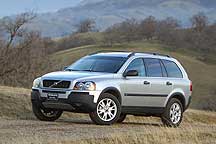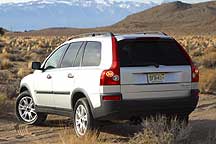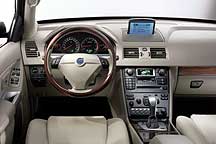
Car Review of the 2003 Volvo XC90 Mid-Size Sport Utility Vehicle
Base MSRP Range: $33,350 to $39,975
Base Invoice Range: $31,349 to 37,576
Price Quote
MSRP As Tested: Not Available
Versions: 2.5T, 2.5T AWD, T6 AWD
Vehicle Category: Mid-Size Luxury SUV
Engine Location: Front Engine
Drive Wheels: href="#glossary">Front-Wheel Drive
Engine As Tested: Standard 2.9-liter, Twin Turbocharged, Dual Overhead Cam, 24-valves, Inline-6 cylinder, 268-horsepower at 5,100rpm and 280 lb-ft torque from 1,800 to 5,000 rpm.
Standard Engine: 2.5-liter, Turbocharged, Dual Overhead Cam, 20-valves, Inline-5 cylinder, 208-horsepower at 5,000rpm and 235 lb-ft torque from 1,500 to 4,500 rpm.
Transmission As Tested: Standard 5-Speed Automatic on 2.5T and 2.5T AWD, 4-speed Automatic T6 AWD.
Fuel Economy (city/hwy): 2.5T and 2.5T AWD – 18/24. T6 AWD – 15/20.
Standard Safety Features: Driver and front passenger, front airbags, ventilated, power-assisted, front disc brakes with rear drum brakes, Traction Control (optional in i), In-Trunk Emergency Trunk Release, Remote Keyless Entry.
Competition: BMW X5, Mitsubishi Endeavor, Lexus RX330, Volkswagen Touraeg, Infiniti FX3.5/4.5, Mercedes-Benz M Class
TREASURE ISLAND, Calif. -- A field of black asphalt on a lot overlooking San Francisco Bay works as a temporary track to test the sure-footed stance of the XC90, a new sport-utility wagon from Volvo of Sweden.
Orange plastic traffic cones aligned in two rows define a narrow path set up to simulate an emergency lane-changing maneuver. At the mid-point of the chute, the cones move abruptly over to an adjacent lane because a barrier blocks the straight path.
Object of this test is to run the XC90 at 40 mph and -- without tapping the brake pedal -- turn quickly to move into the other lane and steer around the barrier.

This side-stepping action simulates an all-too-common situation confronting motorists in traffic: Some other vehicle or object or perhaps even a person suddenly appears ahead in the lane, and the driver faces the instantaneous choice of either continuing straight and colliding with the intruder or quickly cutting the wheel to the left or right to steer around the problem and avoid a disaster.
Drive a high-hiking sport-utility wagon, however, and that quick lane-changing maneuver may also be risky because the sudden veering motion can shift the weight of the top-heavy vehicle to the side and set up a dangerous roll-over.
But that's not the way it works when steering the XC90.
This SUV -- riding on the chassis of a car and rigged with a turbo-charged powertrain plus all-wheel-drive (AWD) traction -- also carries the entire complement of electronic safety controls that characterize Volvo vehicles.
Among the alphabetical soup of acronyms for safety gear is an anti-lock brake system (ABS) and traction control (TRACS) plus Volvo's Dynamic Stability and Traction Control (DSTC), which employs an on-board computer and various lateral plus linear motion sensors tied to ABS, TRACS and the engine's throttle. DSTC monitors the vehicle's forward progress and -- if dangerous oversteer or understeer skidding is detected -- it acts automatically to correct the unstable maneuver by braking wheels or cutting the throttle.
In addition to DSTC yaw control, Volvo overlays the device with a Roll-Over Protection System (ROPS) which adds Roll Stability Control (RSC) with gyroscopic sensors measuring the risk of rolling over.
If these gyro sensors detect that XC90 is about to roll, the RSC automatically counteracts that body movement by activating the DSTC, which then may brake an individual wheel and force an understeer maneuver to block the roll.
That's what happens when one XC90 takes a severe swerve during tests on the parking lot in San Francisco Bay: It performs the side-stepping move in three precisely executed turns and returns to the intended course as the electronic gizmos modulate slipping and non-slipping wheels to hold all tires on pavement.
Such a display of agility signifies that the XC90 driver can maintain keen control over the wagon, which becomes a key defense mechanism for driving safely.
Of course, vehicle safety has long been a hallmark of Volvo cars in a line marked with innovations in both active and passive safety systems.
Volvo's concept for a SUV is that the wagon must first provide as safe an environment for passengers as possible.
As a result, XC90 carries Volvo's entire repertory of safety gear, beginning with a stiff core superstructure of high-strength steel ringing the passenger compartment and crush zones front and rear to absorb impact forces of a collision and deflect them from the cabin.
Further, reinforced braces for the roof and side doors plus thick supportive side pillars lessen cabin intrusions.
Riders are protected by passive safety devices like frontal air bags and side-impact air bags in front seats plus Volvo's side curtain-style air bags reaching clear back to the third row. And to damp the whiplash effect during a rear impact, front seatbacks instantly move rearward to pare acceleration forces on the passenger's back and neck.

Volvo's new XC90 is svelte in package design and expansive in cabin size -- with optional third-row seats for a capacity of as many as seven passengers.
Built off the P2 platform that underpins Volvo's mid-size models (flagship S80 and S60 sedans plus V70 and XC70 wagons), XC90 rides and drives more like a car than a lumbering sport-ute, despite its hulking size.
It can be quick and enthusiastic too, particularly when equipped with a twin turbo in-line-six engine borrowed from the S80 T6.
This 2.9-liter plant achieves high torque at relatively low engine speed and without a typical turbo's acceleration lag. With dual cams on top and continuously variable valve timing, it produces 268 hp at 5100 rpm and 280 lb-ft of torque between 1800 and 5000 rpm. Base powertrain is a light-pressure turbo 2.5-liter five-in-line from Volvo's V70 2.5T. It's rated at 208 hp at 5000 rpm with 236 lb-ft of torque for 1500-5000 rpm.
Electronic automatic transmissions -- a five-speed for the T5 and four-speed for T6 -- employ adaptive gear shift patterns which eliminate the need for separate economy and sport modes. A Geartronic add-on permits shift-it-yourself maneuvers by throwing the gear lever to the left through a gate, then pushing it forward to bump up a gear or pulling back to drop down one gear at a time.
XC90 models with AWD equipment land first in North America, with a T5 version in front-wheel-drive (FWD) also due but arriving late in the model-year.
The AWD system, developed for Volvo by Haldex, a Swedish pioneer in AWD mechanisms, is classified as an active-on-demand system with power split between front and rear wheels through a wet multi-plate clutch.
An electronic device on the rear differential governs the system while also communicating with the car's engine control module and brake controller. When spin sensors at wheels detect rotational differences between front and rear tires, this mechanism reacts by sending more power to non-slip wheels and less to spinning ones. Ultimately, the unit brings both front and rear wheels back into equilibrium -- and the vehicle continues in a straight-line path.
The design of the cabin for XC90 is impressive -- it's stocked with comfortable seats and plenty of cargo room.
Standard is a five-seat arrangement with twin front buckets and a bench for three. A third-row bench for two is optional and folds flat into the floor when more cargo space is needed. Second-row seatbacks also fold flat, as does the front passenger seat, so the compartment ends up with numerous combinations for hauling people and gear.
Volvo tags the front-drive XC90 at $33,350, plus a delivery fee of $625. The T5 AWD comes to $35,100 and a T6 AWD is $39,975. Premium gear like leather seats and deluxe audio equipment cluster in packages as options.
Editors' Ratings
Pros: Coming Soon
Cons: Coming Soon
Ratings (1-10)
- Style: 6
- Performance: 7
- Price: 7
- Handling: 8
- Ride: 8
- Comfort: 9
- Quality: 7
- Overall: 7.43
More Data
Where Built: Gothenburg, Sweden
Major Options: Bi-Xenon Headlamps (GDL) with Automatic Level Control (requires Climate Package), Integrated Center Booster Cushion, Second Row (slides forward only when ordered in the Versatility Package), Volvo Navigational System with DVD Map Data and Remote Control (requires Premium Package for 2.5T), Premium Sound System, AM/FM In-Dash 6-CD Changer, Dolby Pro-Logic II® Surround Sound, 305W, 12 Premium Speakers (requires Premium Package for 2.5T), Rear Audio Headphone Outlets and Controls (requires Premium Package for 2.5T) Subwoofer (not available with Versatility Package and requires Premium Package for 2.5T.
Seating: 7
Number of Rows: 3
Crash Test Ratings:
- NHTSA Frontal Impact/Driver Crash Test Rating: Not Yet Tested
- NHTSA Frontal Impact/Passenger Crash Test Rating: Not Yet Tested
- NHTSA Side Impact/Front Seat Crash Test Rating: Not Yet Tested
- NHTSA Side Impact/Rear Seat Crash Test Rating: Not Yet Tested
- NHTSA Rollover Resistance Rating: Not Yet Tested
- IIHS Frontal Offset Crash Test: Not Yet Tested
Length in Inches: 175.3
Warranties: 4 years/50,000 miles bumper-to-bumper, 4 years/unlimited miles free Roadside Assistance.
Weight in Pounds: 4,450.
Cargo Capacity in Pounds: Not Available
Gross Maximum Vehicle Weight in Pounds: Not Available
Towing Capacity in Pounds: 5,000
Gas Tank Capacity in Gallons: 19
Destination Charge: $660




